PDF chapter test TRY NOW
Art and Architecture:
- The Early Mughal rulers were great patrons of architecture who during their reign constructed numerous architectural splendours that still stands the test of time.
- These buildings are built with numerous styles which were infused in India after the Mughal’s advent. Every ruler of the Mughal empire contributed to architecture in one or the other forms.
Babur
- Being the founder of the Mughal empire in India, Babur is also credited for introducing the “Charbagh Style of Gardens”, in which buildings are built at the centre and the four sides are surrounded by Gardens.
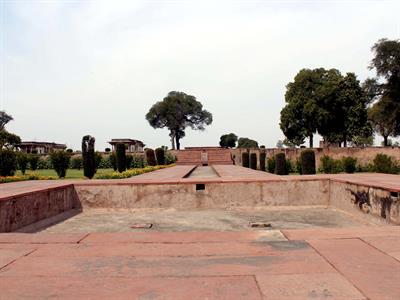
Ram Bagh Gardens
- Babur is also praised for the introduction of the “Persian Style of Architecture in India” during his reign.
RAM BAGH: This was the first Mughal Garden built in India in 1528. It was constructed under Babur.
Humayun
- As Humayun was constantly embroiled in a tussle with Sher Shah during his period he cannot undertake any construction activities. Humayun laid the foundation stone for his city “Dinpanah” but could not complete it.
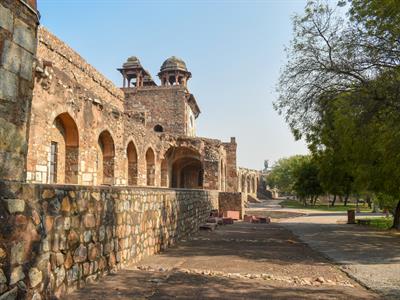
Purana Qila
- Hamida Begum the widow of Humayun constructed “Humayun’s tomb” in memory of his late husband, which was touted as the precursor to Taj Mahal. This tomb was built under the style of Indo – Persian.
PURANA QILA: It was built by Sher Shah of the Sur dynasty, who established other buildings like the Mausoleum he built in Bihar.
Akbar
The Period under Akbar witnessed huge developments in Mughal architecture, where he went on to build a new city named “Fatehpur Sikri”, which was the first planned city in the Mughal empire. It was later made his capital.
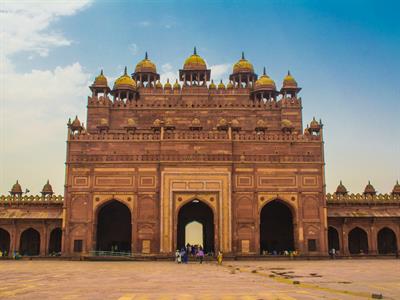
Buland Darwaza
- He also built the “Buland Darwaza” to commemorate the victory over the ruler of Gujarat. Usage of Red Sand Stone was highly prevalent during his period.
GOVIND DEV TEMPLE: Akbar during his tenure built a temple for Lord Govind dev in Vrindavan, which was the first Hindu temple built by a Muslim ruler in India.
Some of the other architectural epithets built during his reign are,
- Tomb of Salim Chisti.
- Diwan-i-Khaas.
- Birbal’s House.
- Ibadat Khana.
- Diwan-i-aam
- Jama Masjid.
Jahangir
- The Ruler had the highest penchant for arts among the Mughal rulers. His period witnessed the culture of Building aesthetic gardens, Shalimar Bagh in Kashmir can be quoted as one of the finest examples of Jahangir period architecture.
- He was the first Mughal ruler who introduced the method of “Portrait Painting” of the rulers, and the Halo around the Kings head was drawn for the first time during his reign.
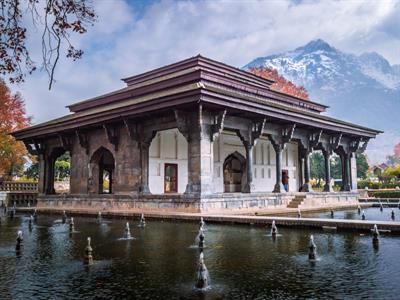
Shalimar Bagh
- The tomb of Itmaad-ud-Daula was built by Jahangir in memory of his father-in-law and he also completed Akbar’s tomb in Sikandara.
Shah Jahan
- Shah Jahan’s reign was the period during which the architectural epithets of Mughals reached their Zenith. He was fondly called by the artisans as the “Prince of Builders”.
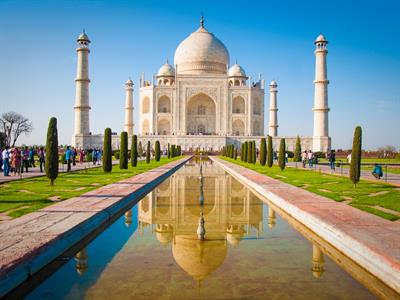
Taj Mahal
- Shah Jahan also built “Shahjahanabad” which served as his capital during his regime. The “Golden Peacock throne” was specially made for the King where he sat and undertook his administration.
TAJ MAHAL: Revered as the “Symbol of Love” for ages the white marble structure was built by Shah Jahan in memory of his wife “Mumtaj”. It was constructed on the banks of river Jamuna (Yamuna).
- Other structures like Moti Masjid, Agra Fort, Red Fort, Sheesh Mahal were built under his rule.
Aurangzeb
- The last great ruler of the Mughal empire, he was the contrast of his predecessors as his thoughts were more inclined towards territorial expansion and didn’t give importance to Arts and Architecture.
- “Bibi-ka-Maqbara”, a white pearl Mosque was built in Aurangabad in memory of his wife was the only architectural splendour of his period.
- It was built by his son, Prince Asam Shah, which carried the nickname “Taj of the Deccan”.
The Policy of Religions under Mughals:
- The Mughal ruler of the earlier periods had a softer stand towards people of other sects. Emperor Akbar embraced many cultures and patrons during his regime which earned him high respect among his contemporaries.
- His successors Jahangir and Shah Jahan also had liberal stand towards other sects, during later period Aurangaseb didn’t encourage religions other than Islam which gained him more enemies.
